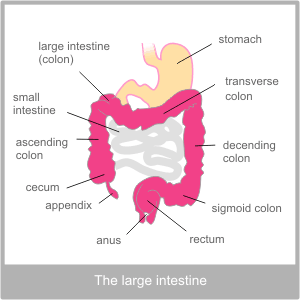The Large IntestineThe Anatomy of the Large Intestine
The large intestine is the last section of the digestive tract. At around 1.5 meters, the large intestine is not as long as the small intestine, but it is wider. It takes a route that bends up and around the small intestine like an arch.
The first part of the large intestine is called the caecum. As you can see from the image the caecum is a bit of a dead end in the intestines. This is reflected in its name which means 'blind ending'. This part of the large intestine leads to the appendix and is much longer in animals that eat only vegetation, particularly grass. In animals such as sheep the caecum contains bacteria that are capable of breaking down cellulose.
The Physiology of the Large Intestine
Food that has passed through the stomach and the small intestine is finally deposited in the tube like structure of the large intestine to be further broken down.
The large intestine is specified to its role because it contains the 'healthy bacteria' that we hear about that help us to break down food and make certain vitamins such as Folic acid and Vitamin K. The by product of this process is gas which eventually escapes as flatulence. The contents of the large intestine, which are initially fairly fluid, are moved along its track by slow, infrequent contractions of the muscles in its walls. This allows the time required to extract up to seventy percent of the liquid and as much nutrition as possible.
When the slow contractions do come they propel waste products from the large intestine into the rectum where they will be stored until they are finally evacuated. The walls of the large intestine contain more lymphoid immune tissue than is found in any other area of the alimentary tract, this is thought to protect us from the resident microbes and bacteria. The cell walls also secrete mucus to lubricate the whole process. The faeces that is finally removed from the body, in the form of a bowel movement, contains large numbers of microbes. Although these microbes are performing a vital role in the large intestine they can be harmful to other areas of the body which is why faeces can cause disease.



